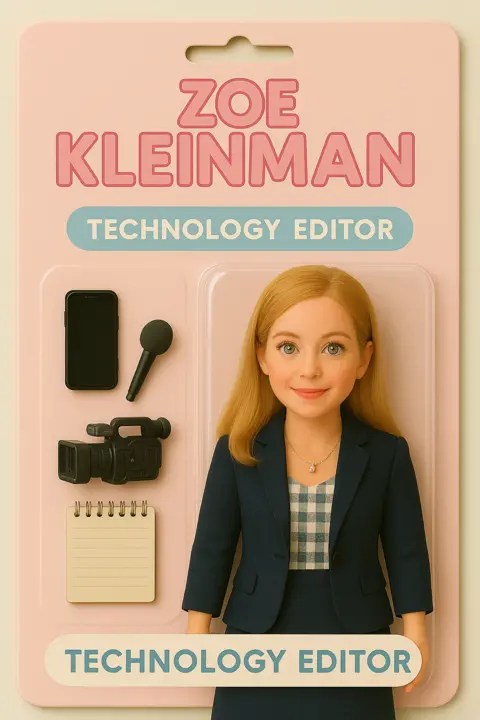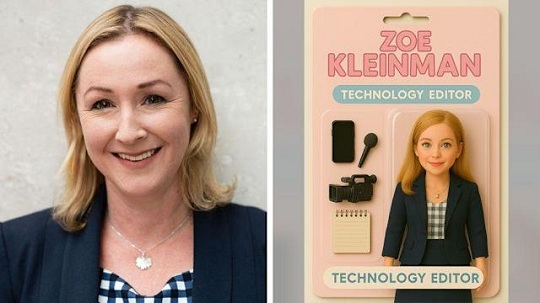When scrolling through social media, you may have recently seen friends and family appearing in miniature.
It's part of a new trend where people use generative artificial intelligence (AI) tools like ChatGPT and Copilot to re-package themselves - literally - as pocket-sized dolls and action figures.
It has taken off online, with brands and influencers dabbling in creating their mini-me.
But some are urging people to steer clear of the seemingly innocent trend, saying fear of missing out shouldn't override concerns about AI's energy and data use.
How does the AI doll generator work?
It may sound complicated, but the process is simple.
People upload a picture of themselves to a tool like ChatGPT, along with written prompts that explain how they want the final picture to look.
These instructions are really important.
They tell the AI tool everything it is meant to generate, from the items a person wants to appear with to the kind of packaging they should be in - which includes mimicking the box and font of popular toys like Barbie.
Many online will then personalise it further with their name, job and clothing choices.
Though it does not always work, and many have also shared some of the amusing mistakes the tools made, where the action dolls look nothing like them.
Like other generative AI tools, image generators are also prone to making things up, and may make assumptions about how someone should look.
And it's not just regular people using it - the trend has been seized upon by a wealth of brands online including beauty company Mario Badescu and even Royal Mail.
What's the appeal?
Trends come and go - but by their very nature can make people feel compelled to take part to avoid missing out.
"Generative AI makes it easier and quicker for people to create and jump on trends," says Jasmine Enberg, principal social media analyst at eMarketer.
She said the technology had made it quicker and easier to make online content, which may have the unexpected effect of quickening the pace at which other social media users get annoyed by it.
But she believe AI-driven trends will become a more regular appearance on our feeds "as the tech becomes a more regular part of our digital lives".
What are the big concerns?
But while its light-hearted nature may have drawn people to it, the trend has drawn criticism from some concerned about its environmental impact.
Professor Gina Neff of Queen Mary University London told the BBC ChatGPT is "burning through energy", and the data centres used to power it consume more electricity in a year than 117 countries.
"We have a joke in my house that every time we create one of these AI memes, it kills a tree," said Lance Ulanoff, US editor of TechRadar, in an article about the trend.
"That's hyperbole, of course, but it's safe to say that AI content generation is not without costs, and perhaps we should be thinking about it and using it differently."
People have also highlighted concerns copyrighted data may have been used to create the technology which generates images without paying for it.
"ChatGPT Barbie represents a triple threat to our privacy, our culture and our planet," said Ms Neff.
"While the personalisation might feel nice, these systems are putting brands and characters into a blender with no responsibility for the slop that emerges."
And Jo Bromilow, director of social and influencer at PR and creative agency MSL UK, asks: "is a cute, funny result really worth it?"
"If we're going to really use AI properly, we have to set guardrails around how we use it conscientiously," she said.
Testing the AI doll trend
By Zoe Kleinman, BBC technology editor
I started by finding a suggested prompt online - a list of instructions to enter into the AI tool in order for it to generate the image.
You have to upload your own selfie with your prompt and you also have to be very specific about what you want, including a list of which accessories you'd like included and what colour you want the box to be.
 ChatGPT
ChatGPT
When it came to providing my job title, my first attempt was declined because I included BBC News and was told this violated content policy - I think because currently the BBC does not allow ChatGPT to use its output.
Once you do get an image you're likely to want to tweak it further; my first attempt was too cartoon-like.
The following, more realistic version made me look considerably older than I am, then too child-like, and I gave up in the end trying to get it to use my actual eye-colour, which kept defaulting back to blue (mine are a blend of hazel and green).
It took a couple of minutes to generate each version and overall the process was slower than I would have liked, potentially because of its popularity.
It did start to feel like a lot of work for a passing trend, and it isn't perfect - my doll is expanding out far beneath the supposed packaging.
But more importantly, somewhere in a data centre some hot computer servers were toiling away to make Action Figure Zoe.
They almost certainly could have been put to work on worthier causes.
BBC





